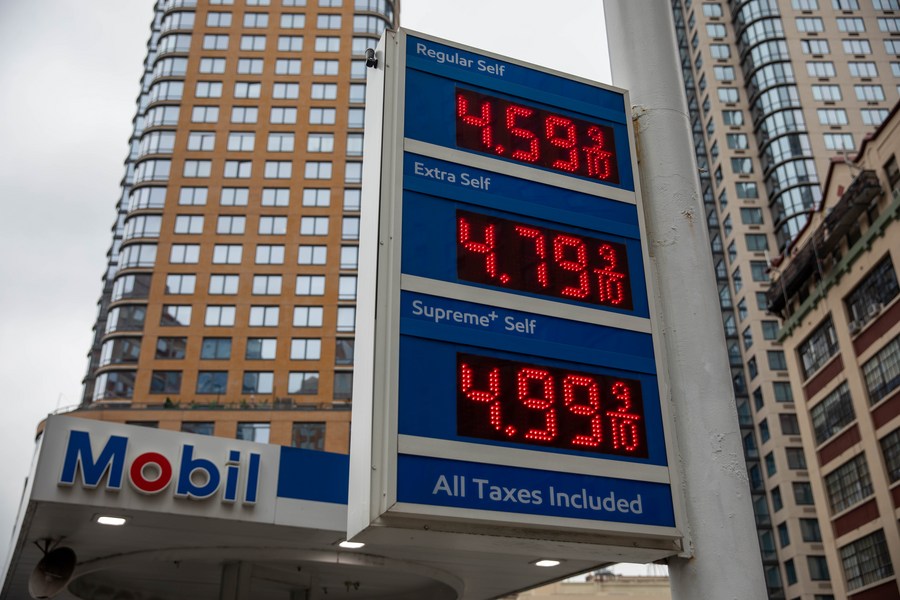U.S. economy grows at annualized 2.0 pct in Q3 amid Delta surge, supply bottleneck

Patrons dine at a restaurant in Navy Yard neighborhood in Washington D.C., the United States on Aug. 31, 2021. (Photo by Ting Shen/Xinhua)
The deceleration in real GDP in the third quarter was partially driven by a slowdown in personal consumption expenditures (PCE), which grew at 1.6 percent after a 12-percent jump in the prior quarter, the report showed.
WASHINGTON, Oct. 28 (Xinhua) -- The U.S. economy grew at an annual rate of 2.0 percent in the third quarter amid the Delta variant-fueled COVID-19 surge, after expanding 6.7 percent in the second quarter, the U.S. Commerce Department reported Thursday.
"The increase in third quarter GDP reflected the continued economic impact of the COVID-19 pandemic," the department's Bureau of Economic Analysis said in an advance estimate.
"A resurgence of COVID-19 cases resulted in new restrictions and delays in the reopening of establishments in some parts of the country," the bureau noted. "Government assistance payments in the form of forgivable loans to businesses, grants to state and local governments, and social benefits to households all decreased."
Jason Furman, former chairman of the White House Council of Economic Advisers, tweeted that government spending in the form of stimulus payments "fell a lot" in the third quarter and "likely played some role in the slowdown in personal consumption growth."
Aside from surging COVID-19 cases and waning government support, the U.S. economy is seeing continued supply chain disruptions, which have pushed up inflation and could dampen the economic outlook going forward.
The 2.0-percent growth pace was lower than the 2.8-percent rate estimated by economists surveyed by The Wall Street Journal.

People shop for vegetables at a market in New York, the United States, on Oct. 13, 2021. (Xinhua)
The increase in real GDP in the third quarter reflected increases in private inventory investment, personal consumption expenditures (PCE), state and local government spending, and nonresidential fixed investment, said the report.
The deceleration in real GDP in the third quarter was partially driven by a slowdown in PCE, which grew at 1.6 percent after a 12-percent jump in the prior quarter, the report showed.
From the second to third quarter, spending for goods was down, led by motor vehicles and parts, and services decelerated, led by food services and accommodations, according to the report.
"An ugly summer's end for the U.S. economy ... but momentum has already picked up," said Gregory Daco, chief U.S. economist at Oxford Economics, who also noted that GDP grew by 1.4 percent relative to pre-pandemic levels.
The latest GDP data came about a week after the Federal Reserve released its latest Beige Book, which showed that U.S. economic growth slowed from mid-August through September, constrained by supply chain disruptions, labor shortages, and uncertainty around the Delta variant.
The Fed survey noted that most districts reported "significantly elevated prices," fueled by rising demand for goods and raw materials. "Reports of input cost increases were widespread across industry sectors, driven by product scarcity resulting from supply chain bottlenecks," it said.

Gas prices are displayed at a gas station in New York, the United States, on Oct. 13, 2021. (Xinhua)
The Labor Department recently reported that U.S. inflation remained elevated in September as supply chain disruptions had persisted for months, with the consumer price index rising 5.4 percent over the 12 months ending September.
U.S. Treasury Secretary Janet Yellen said on Sunday that on a 12-month basis, inflation will remain high into next year because of recent events, but she expected inflation to fall to acceptable levels in the second half of next year.
In the latest World Economic Outlook released earlier this month, the International Monetary Fund projected the U.S. economy would grow by 6.0 percent this year, down 1.0 percentage point from its July projection.
Photos
Related Stories
- Yellen expects U.S. inflation to fall to acceptable levels in second half of next year
- U.S. growth slows amid supply chain disruptions, labor shortages, Delta surge: Beige Book
- Powell says Fed can't protect economy in event of U.S. default
- U.S. equities log weekly decline amid pandemic worries, mixed economic data
- Biden should prioritize reversing Trump's trade policies: economist
Copyright © 2021 People's Daily Online. All Rights Reserved.










